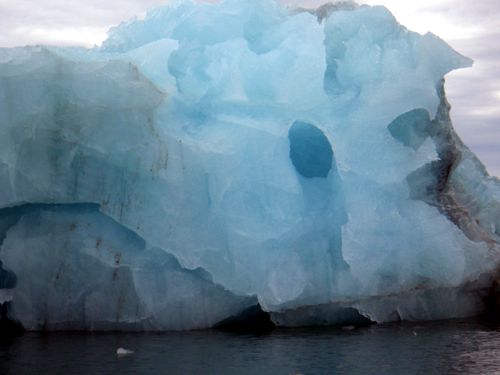We do not do as much field work as I expected at the beginning, because of the weather and because we need to do laboratory experiments to check different theories. But today I am happy: the weather is cooperating, and we are away in the field once again.
The glacier has changed over the last days, with more and more blue ice and blue icebergs. Ice from the top of the glacier is white, and becomes blue when it is compressed at the base of the glacier. The front of Hansbreen is gleaming in different shades of blue today, meaning more ice from the base has been exposed and is now melting. There are large blue icebergs all around us.

The icebergs in the fjord have various shades and various shapes. Some of them are so flat that I would like to step on them (too dangerous to even think about, of course, as their bobbing in the waves reminds us how unstable they are). A Canadian friend sent me the link to a video showing a large iceberg capsizing: very illustrative, even though I prefer watching it with the sound off. Other icebergs look like melting bouncy castles, complete with high towers and oscillations. Some are smudged with grey or brown: remnants from the base of the glacier, gravel or mud taken with the ice as it moves slowly but ineluctably. Sometimes, the icebergs still have huge stones caught into the ice. This one (below) looks a gruyere cheese: the holes were once occupied by round stones, which fell into the water as the ice melted. Closer to the Station, on our way back, some of the icebergs with the most melting behind them look like swans: all white with slender necks …

During our first deployment of DAB, a little auk swam enquiringly toward us, curious of what we were doing. After seeing it was “just science”, it swam further away, and started ducking its head into the water at regular intervals to find some food.
Once back on shore, late into the night, I have time to glance outside whilst downloading the data from the day. Some sort of eagle is swooping over one of the barnacle goose chicks by the melt pond, and even the parents (usually aggressively protective of their young) do not seem ready to approach. But the chick runs to water … and apparently to safety, as the eagle now flies higher and finally leaves off …
Respond